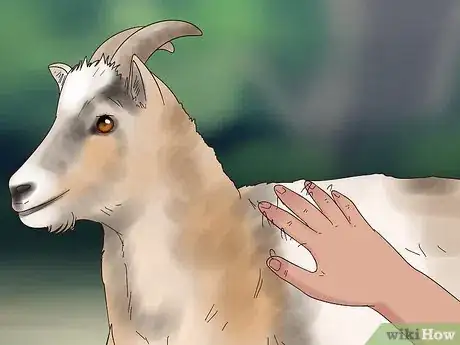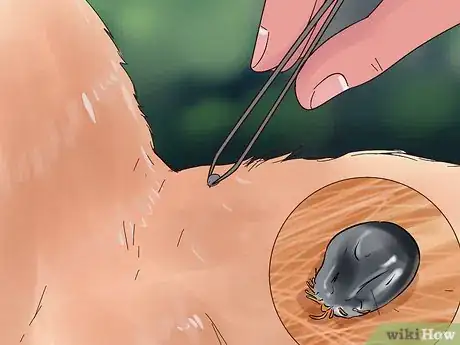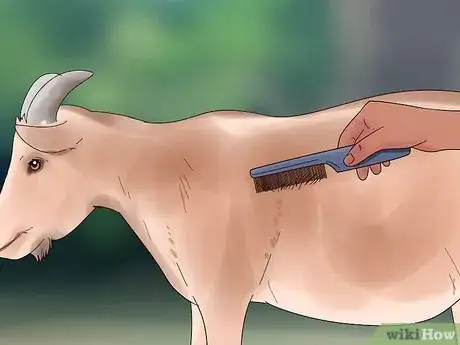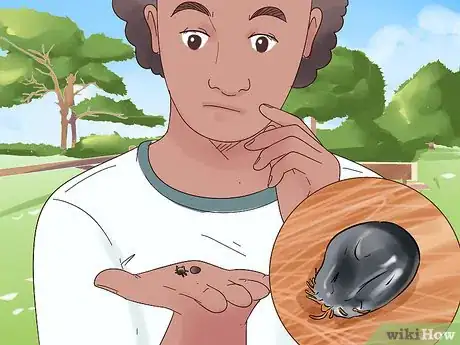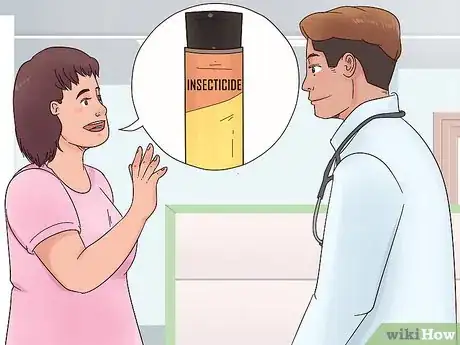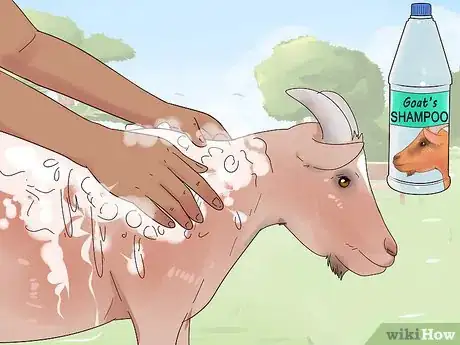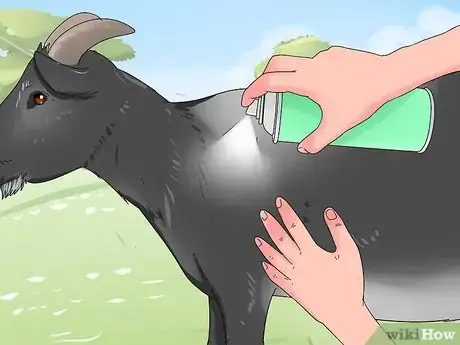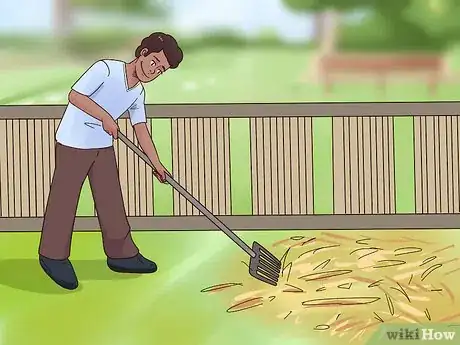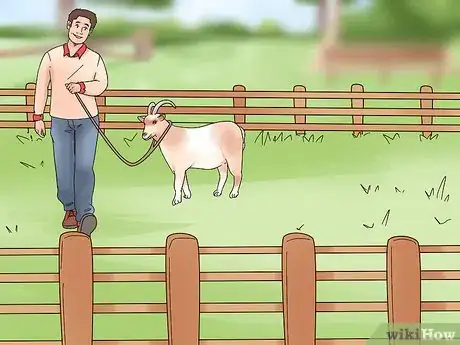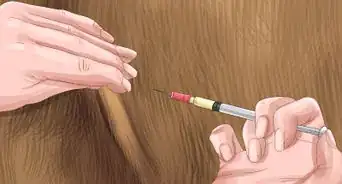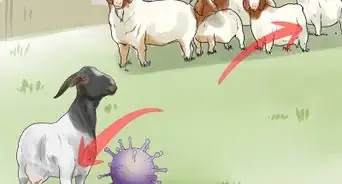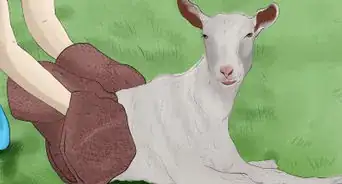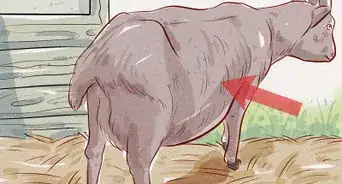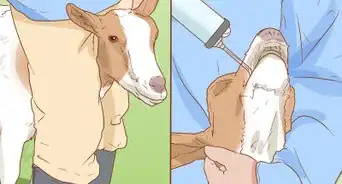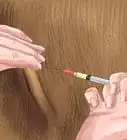This article was co-authored by wikiHow Staff. Our trained team of editors and researchers validate articles for accuracy and comprehensiveness. wikiHow's Content Management Team carefully monitors the work from our editorial staff to ensure that each article is backed by trusted research and meets our high quality standards.
There are 12 references cited in this article, which can be found at the bottom of the page.
This article has been viewed 43,256 times.
Learn more...
Tick and flea infestations can cause any number of problems in a goat herd, from disrupting healthy fleece and milk production to causing anemia and poor health overall. By removing ticks and fleas by hand, treating tick and flea outbreaks with shampoo and insecticide, and controlling your goats’ environment to prevent tick and flea infestations from the beginning you can keep your herd both healthy and happy.
Steps
Removing Ticks and Fleas by Hand
-
1Find all ticks on your goat’s body before removing them. Run your fingers through your goat’s fur to feel for any small lumps that might be a tick, checking visually to confirm the lumps are ticks after finding them. Inspecting your goat beforehand can help keep you from missing any ticks that may be hiding in hard-to-reach areas.[1]
- Inspect more closely in dark, moist areas like the ears, groin, and eyelids.[2]
-
2Remove ticks with tweezers. Grasp ticks above the head with tweezers and detach them from your goat’s skin by pulling gently. [3] Save the ticks in a plastic bag or pill bottle so that your veterinarian can test them for diseases they may have passed to your goats.[4]
- Failing to remove the entire head of the tick from your goat’s skin can cause infection.[5]
Advertisement -
3Use a flea comb to rid your goat of fleas and flea dirt. Comb over your goat’s entire body in the direction of the fur to remove fleas and flea dirt (small, dark clumps of flea feces). Start with the head and work your way to the tail, then work from the chest down your goat’s belly. Make sure to also comb the fur on the legs.[6]
Treating Tick and Flea Outbreaks with Shampoo and Insecticide
-
1Identify the specific tick or flea species infesting your goat(s). Use an identification key (http://www.tickencounter.org/tick_identification for ticks; http://www.wrbu.org/VecID_FL.html for fleas) to figure out what type of tick or flea your goat has. Different species require different insecticides, so you’ll need to know before you pursue treatment.[9]
- If you’re having trouble identifying the species of the tick or flea, you can always ask your veterinarian to make a house call to assist you.[10]
- The most common species of fleas that infest goats are the cat flea and the sticktight flea.
- The most common species of ticks that infest goats are the American Dog Tick, the Gulf Coast Tick, and the Lone Star Tick.[11]
-
2Consult your veterinarian on the best insecticide for treatment. Once you’ve identified the specific tick or flea species infesting your goat, call your veterinarian to find out which insecticides combat those species most effectively.[12]
- The most common insecticide used with goats (permethrin) can be purchased online, at pet stores, or farm supply chains.[13]
-
3Wash your goat’s fur with flea shampoo and give them water to drink before applying insecticide. Spray your goat down with water and apply a veterinarian-recommended flea shampoo to its fleece to remove as many fleas as possible before applying insecticide. Then, spray your goat with water again to rinse out the shampoo.[14]
- Giving your goat water to drink can keep them from getting thirsty and drinking the insecticide.[15]
- Make sure to wear gloves to protect yourself from fleas, ticks, or irritants in the shampoo.[16]
- Don’t use a human shampoo. Human shampoos can irritate your goat’s skin.[17]
- After washing your goat’s fur, you may choose to shear your goat if it’s around the time you regularly do so to remove many (but not all) of the ticks and fleas.[18]
-
4Apply insecticide every 30 days for 3 months. Spray the insecticide down your goat’s spine, under the chin, and on the chest between its two front legs. Rub the insecticide into their fur with your hands to evenly spread it around their body.[19]
- Make sure to avoid the eyes, ears, nose, and mouth.[20]
Preventing Tick and Flea Infestations
-
1Change your goats’ bedding regularly. Fleas lay eggs on goats, which then drop down onto the ground to be hatched. The hay or other bedding material your goats use provides the perfect environment for flea larvae to grow into adult fleas and return to your goats’ fur. Change your goats’ bedding regularly to deprive fleas of a natural habitat.[21]
- Dry bedding favors the development of fleas, while wet bedding can attract flies. Change dry bedding every 2 weeks to prevent fleas from finishing their life cycles.[22]
-
2Rotate your goats’ grazing pastures. Ticks thrive in grazing pastures with tall grass, so it’s important to move your goats between different areas on a regular basis. This way, their grazing pastures won’t grow too long and ticks won’t have a hospitable environment in which to live.[23]
-
3Cut vegetation short around shelter areas. Make sure to keep any vegetation that might grow around the barn or shelter where your goats sleep as short as possible. Doing so will deprive ticks of an environment conducive to growth.[24]
-
4Treat your herd dogs for ticks and fleas. Fleas can very easily transfer from your herd or guard dogs to your goats. Be sure to treat your dogs regularly for fleas and ticks to prevent infestations from spreading between them and your goat herd.[25]
- Make sure to consult your veterinarian about the proper insecticide to use with your dogs.[26]
-
5Quarantine new additions to your herd for 30 days. Parasites like fleas and ticks are often introduced to herds when a new goat is added. Always be sure to quarantine new herd additions for 30 days to ensure that the new goat isn’t infested with fleas or ticks that could spread to the rest of the herd.[27]
- If you find fleas or ticks on your new goat, be sure to exterminate them before adding the goat to your herd.[28]
Things You’ll Need
- Tweezers
- Flea comb
- Flea shampoo
- Gloves
- Shears
- Insecticide
References
- ↑ https://www.petmd.com/dog/parasites/finding-ticks-your-dog-5-places-look
- ↑ https://www.petmd.com/dog/parasites/finding-ticks-your-dog-5-places-look
- ↑ http://animals.mom.me/tick-control-cattle-11372.html
- ↑ https://www.petmd.com/dog/dos-and-donts-tick-disposal
- ↑ http://animals.mom.me/tick-control-cattle-11372.html
- ↑ http://www.thebugsquad.com/fleas/flea-comb-guide/
- ↑ http://www.thebugsquad.com/fleas/flea-comb-guide/
- ↑ http://www.thebugsquad.com/fleas/flea-comb-guide/
- ↑ http://pods.dasnr.okstate.edu/docushare/dsweb/Get/Document-5175/EPP-7019web.pdf
- ↑ http://pods.dasnr.okstate.edu/docushare/dsweb/Get/Document-5175/EPP-7019web.pdf
- ↑ http://pods.dasnr.okstate.edu/docushare/dsweb/Get/Document-5175/EPP-7019web.pdf
- ↑ http://aces.nmsu.edu/pubs/_b/B112/
- ↑ http://pest.ca.uky.edu/EXT/Recs/ENT22-Sheepgoats.pdf
- ↑ http://animals.mom.me/how-to-use-frontline-on-goats-12356125.html
- ↑ http://animals.mom.me/how-to-use-frontline-on-goats-12356125.html
- ↑ http://animals.mom.me/how-to-use-frontline-on-goats-12356125.html
- ↑ http://animals.mom.me/how-to-use-frontline-on-goats-12356125.html
- ↑ https://www.hobbyfarms.com/how-to-spot-treat-goat-parasites/
- ↑ http://animals.mom.me/how-to-use-frontline-on-goats-12356125.html
- ↑ http://animals.mom.me/how-to-use-frontline-on-goats-12356125.html
- ↑ http://pods.dasnr.okstate.edu/docushare/dsweb/Get/Document-5175/EPP-7019web.pdf
- ↑ http://parasitipedia.net/index.php?option=com_content&view=article&id=2396&Itemid=2656
- ↑ https://www.hobbyfarms.com/how-to-spot-treat-goat-parasites/
- ↑ http://pods.dasnr.okstate.edu/docushare/dsweb/Get/Document-5175/EPP-7019web.pdf
- ↑ http://www.betterhensandgardens.com/identify-control-goat-external-parasites/
- ↑ https://www.avma.org/public/PetCare/Pages/Safe-use-of-flea-and-tick-preventive-products.aspx
- ↑ http://www.betterhensandgardens.com/identify-control-goat-external-parasites/
- ↑ http://www.betterhensandgardens.com/identify-control-goat-external-parasites/
About This Article
Unfortunately, goats are prone to getting ticks and fleas, but if you treat them thoroughly, your herd can be happy and healthy again. If your goat just has 1 or 2 ticks, you can remove them with tweezers. Grasp the tick above the head with the tweezers and pull gently so you remove the entire tick. For fleas, pull a flea comb over your goat’s body in the direction of its fur to remove them. Start with the head and work your way to its tail to ensure you get them all. You can also use a livestock shampoo to remove fleas or ticks. First, look up an identification guide online so you can figure out what species is on your goat. Then, purchase a shampoo made for that kind of flea or tick. You’ll need to spray your goat down with water, apply the shampoo, then rinse it out with more water. To learn how to apply an insecticide on your goat, read on!
